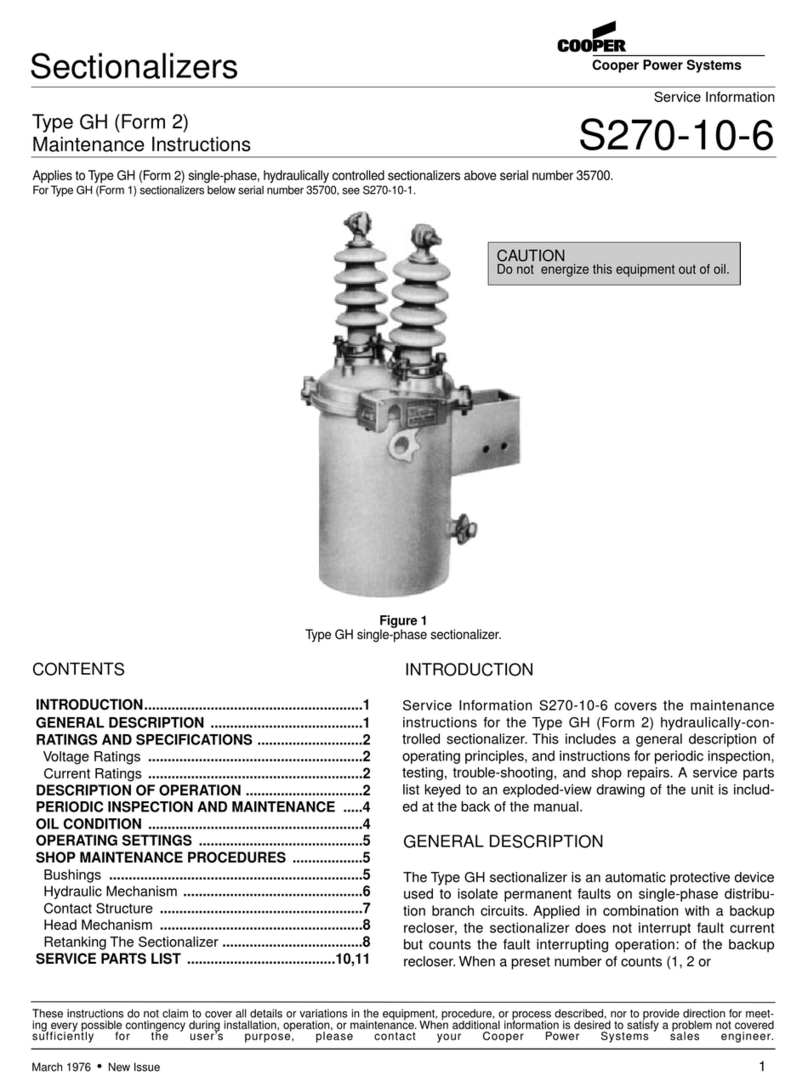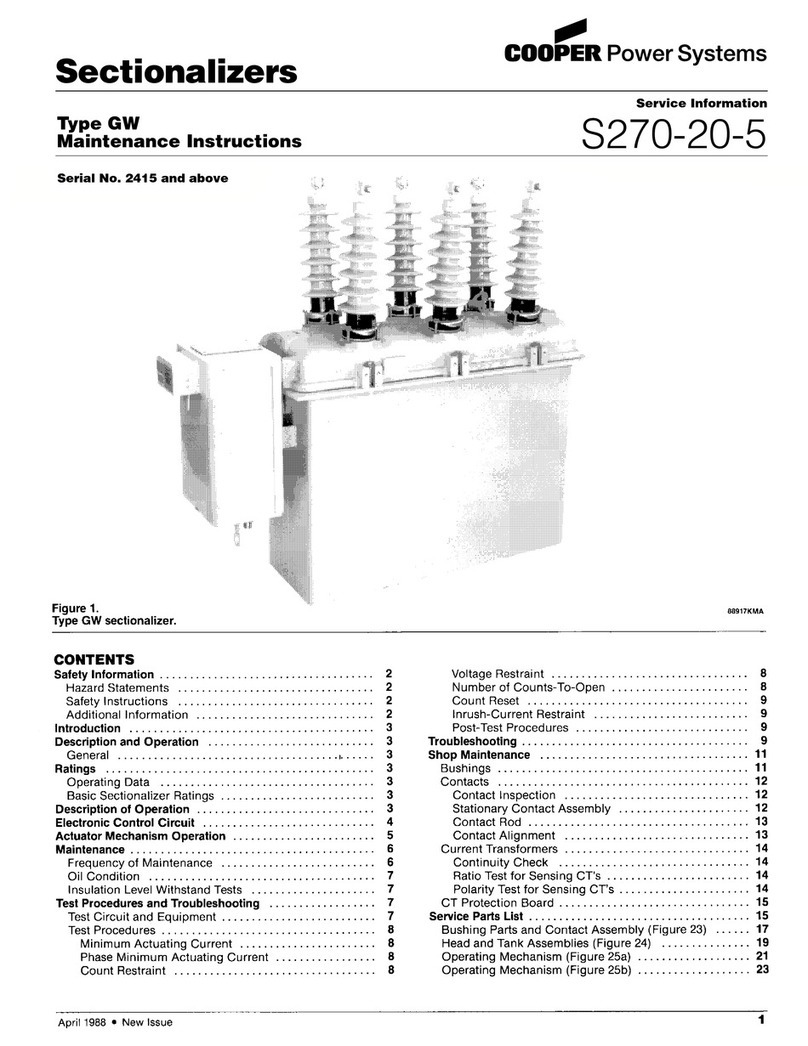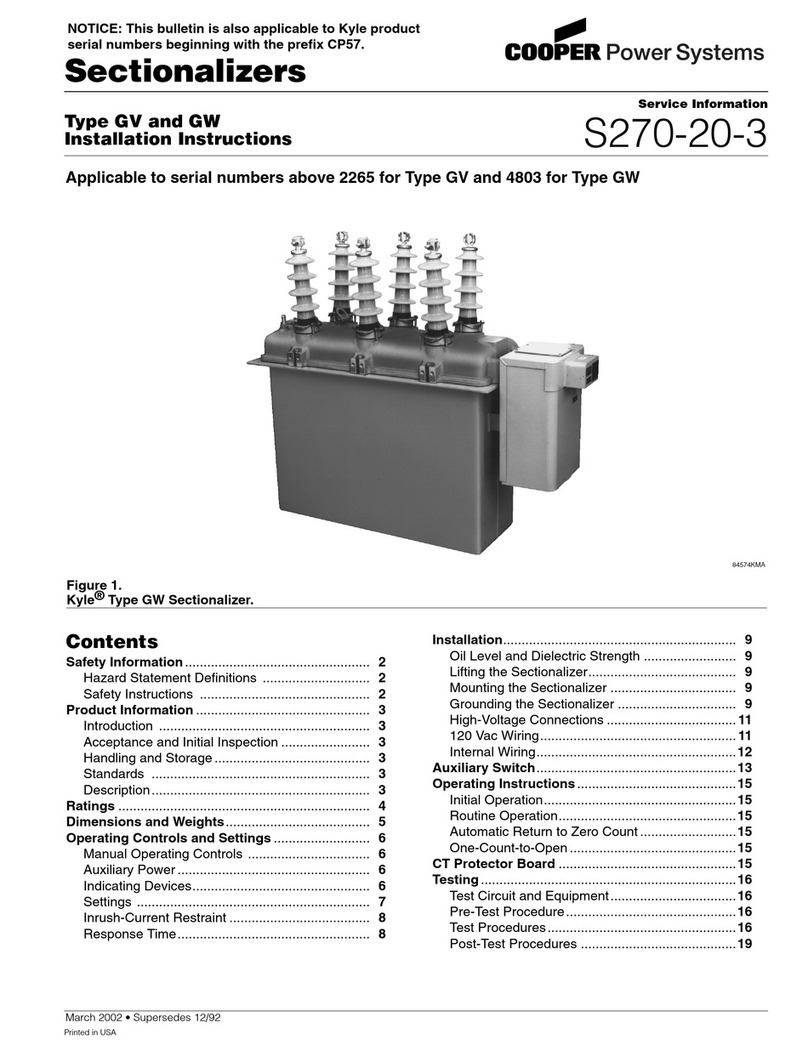Page 2
Fault Current
Percent of Maximum
Interrupting Recloser Circuit
Rating Operations X/RValue
15-20 28 4
45-55 24 8
90-100 10 15
Total 62
DESCRIPTION OF RECLOSER
The Types RVE and WVE reclosers are self-controlled
devices that protect distribution lines and equipment.
Each unit consists of a circuit interrupting device,
hereafter referred to as the recloser, an electronic
control, and a connecting cable. Fault current sensing
is achieved by the control which actuates the recloser.
Circuit interruption is provided by the recloser.
A Type RVE or WVE recloser performs similarly to
other reclosers in that it trips and automatically reclos-
es. If a fault is temporary, reclosing of the contacts
restores normal service. If the fault is permanent, the
recloser senses this by performing a preset number of
operations and locking open. All three phases of a
Type RVE or WVE recloser open and lock out simulta-
neously.
Opening sequences of the recloser can be all fast, all
delayed, or any combination of fast followed by
delayed operations up to a total of four. Fast opera-
tions clear temporary faults before branch-line fuses
can be damaged. Delayed openings allow time for
fuses to clear so permanent faults can be confined to
smaller sections of line.
Arcs are extinguished in the rugged arc-interrupter
assemblies, figure 1, which utilize the proven selfblast
principle of arc interruption. Moving contacts are driv-
en by powerful opening springs that are charged
when the recloser is closed.
Closing is accomplished when a line-voltage solenoid
is connected across two phases of the distribution
line. This connection occurs when a rotary solenoid,
located inside the recloser, allows the closing
solenoid contactor to close.
A trip-free control lever, linked with the interruption
mechanism, is provided to lock the recloser open
manually. This lever, located under the sleet hood,
cannot be used to close the recloser, but it must be in
the CLOSED position before the electronic control
can cause the recloser to close. A contact position
indicator, linked to the interrupting mechanism but
independent of the control lever, is provided under the
sleet hood.
GENERAL MAINTENANCE INFORMATION
Maintenance Ensures Reliable Performance
Reclosers are widely applied to increase service con-
tinuity, reduce system operating costs, and increase
Type RVE Recloser
Fault Current
Percent of Maximum
Interrupting Recloser Circuit
Rating Operations X/RValue
15-20 28 4
45-55 20 8
90-100 10 15
Total 58
Type WVE Recloser
revenue. The Type RVE or WVE performs all these
recloser functions by combining the flexibility and relia-
bility of electronic control with proven interrupting mech-
anisms to achieve superior distribution circuit protection.
However, the recloser can perform at peak efficiency
only if it is maintained in good condition. While mainte-
nance is relatively easy and inexpensive, it is important.
Oil plays an essential role in arc interruption, insulation,
and reclosing. Arc interruption, however, contributes to
oil decomposition. For this reason, the oil steadily dimin-
ishes in dielectric strength as the recloser continues to
clear fault currents. Breathing action may also result in
moisture absorption by the oil, thus lowering its insula-
tion value. For effective recloser operation, oil must be
replaced before it deteriorates beyond a safe level.
Climate and Duty Determine
Maintenance Intervals
Frequency of maintenance depends upon local climatic
conditions and the interrupting duty imposed on the
recloser. M-E recommends the unit be inspected com-
pletely, cleaned, and filled with new oil at least once
each year. If the recloser operates through a duty cycle
in less than one year, periodic maintenance should be
performed then.
The duty cycles are as follows:
































